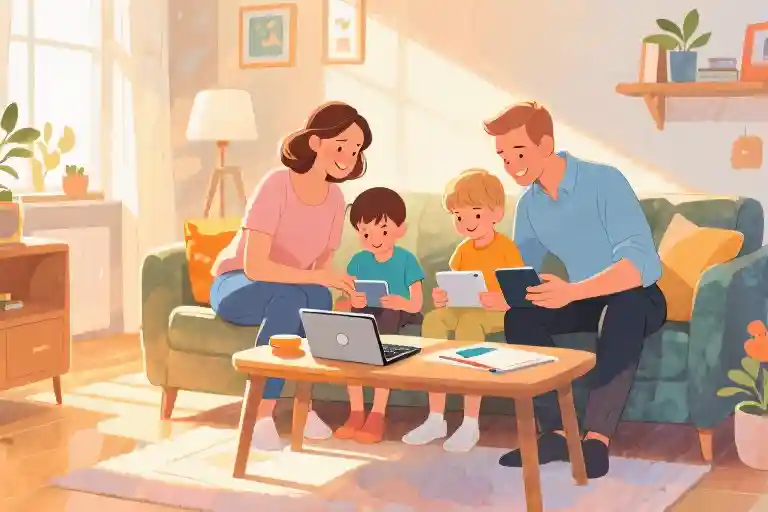The tablet screen casts a faint blue glow on seven-year-old Jamie’s face as his small fingers swipe rapidly across Candy Crush levels. His mother watches from the doorway, torn between pride at her son’s problem-solving skills and unease about his fourth consecutive hour of gameplay. Last week’s optometrist visit confirmed her suspicions – Jamie’s myopia has progressed faster than expected, joining the 42% of children under eight now requiring vision correction linked to excessive screen time. This quiet household scene encapsulates modern parenting’s central dilemma: technology serves as both master key to educational opportunities and invisible shackles to healthy development.
Digital devices have become the new frontier of childhood, replacing backyard trees with touchscreen tablets and playground chatter with multiplayer game banter. Studies show children aged 8-12 now spend an average of 4-6 hours daily consuming media, not including school-related screen use. These numbers represent more than statistics – they reflect childhoods being rewired, with neural pathways forming differently than in previous generations. The American Academy of Pediatrics notes that while carefully curated technology can enhance spatial reasoning and problem-solving abilities, uncontrolled exposure may impair sleep cycles, social development, and even physical coordination.
This paradox leaves parents navigating uncharted territory. Educational apps like Khan Academy Kids demonstrate technology’s potential to personalize learning, adapting to a child’s pace in ways traditional classrooms cannot. Yet these same devices provide unfiltered access to social media platforms where 38% of children under 13 have encountered cyberbullying. The screen itself holds no moral valence – it’s our management of this tool that determines whether it builds or erodes a child’s wellbeing.
Over the following sections, we’ll examine technology’s dual role in shaping young minds. First, we’ll explore its demonstrated benefits for cognitive development and global connectivity. Next, we’ll confront the physiological and psychological costs of unregulated use, supported by emerging research. Finally, we’ll provide actionable strategies tailored to different developmental stages – because a five-year-old’s screen needs differ radically from a teenager’s. Along this journey, we’ll hear from child development specialists, analyze the latest parental control tools, and share real families’ successes and stumbles in finding balance.
The goal isn’t to declare technology inherently good or bad, but to equip parents with evidence-based frameworks for making intentional choices. Because in homes worldwide, versions of Jamie’s story play out daily – and the decisions we make today will echo through our children’s neurological, emotional, and social development for decades to come.
The Educational Benefits of Technology for Children
Digital tools have transformed how children learn and interact with the world. What was once confined to textbooks and classroom walls now extends into interactive, engaging experiences that adapt to individual learning styles. The educational potential of technology isn’t just theoretical—it’s happening in homes and schools every day.
Platforms like Khan Academy demonstrate how technology can democratize learning. A child struggling with fractions at midnight can access step-by-step video tutorials, while another student can explore advanced calculus concepts beyond their grade level. These resources don’t replace teachers—they create opportunities for personalized learning that accommodates different paces and interests.
Beyond academic subjects, technology cultivates skills essential for the modern world. Simple coding games introduce logical thinking patterns, while collaborative online projects teach digital teamwork. The creativity unleashed through animation apps or music composition software often surprises parents who view screens solely as consumption devices. When used intentionally, these tools become workshops for developing problem-solving approaches rather than passive entertainment.
Virtual connections represent another significant advantage. Children maintaining friendships across continents through video calls develop cultural awareness organically. Grandparents reading bedtime stories via tablet bridges generational gaps, while classroom pen pal programs now include real-time collaborations with peers overseas. These interactions build communication competencies that textbooks alone cannot provide.
The key lies in recognizing technology as an amplifier rather than a replacement. An art app won’t make a child Picasso, but it might reveal a passion for design. A math game won’t create a mathematician, but it could transform anxiety into curiosity. Like any tool, its value depends on how we guide children to use it.
The Hidden Costs Behind the Screen
The glow of tablets and smartphones has become as familiar to children as bedtime stories and playground swings. But this constant digital companionship comes with consequences we’re only beginning to understand. While technology undoubtedly opens doors to learning and connection, its overuse quietly erodes fundamental aspects of childhood health and safety.
When Screens Replace Movement
Pediatric clinics report a troubling pattern – children who once complained of scraped knees now present with chronic neck pain and deteriorating eyesight. The correlation between sedentary screen time and childhood obesity isn’t theoretical; studies show each additional hour of daily device use increases BMI by measurable percentages. What begins as harmless entertainment gradually reshapes young bodies – slumped postures, weakened muscles, and circadian rhythms disrupted by blue light exposure. The American Academy of Pediatrics warns that screens in bedrooms delay melatonin production by nearly an hour, turning bedtime into a battleground.
The Dopamine Dilemma
Social media platforms have perfected the art of capturing young attention through intermittent rewards. Those red notification bubbles and like counters aren’t innocent features – they’re carefully engineered triggers that hijack the brain’s reward system. Developmental psychologists observe pre-teens exhibiting anxiety when separated from devices, not because they’re addicted to technology per se, but to the neurochemical hits it delivers. The same neural pathways that should light up during face-to-face interactions become dependent on digital validation instead.
Digital Playgrounds, Real Dangers
Last year’s cybercrime reports contained a disturbing statistic – over 60% of online predation attempts target children under 13 through gaming platforms and social apps. What parents often dismiss as harmless chat functions become gateways for identity theft, grooming, and psychological manipulation. Even seemingly safe educational sites sometimes host third-party trackers harvesting data from young users. The average child has their personal information exposed online 1,500 times before turning 12, often through innocent-seeming quizzes or game registrations.
The paradox of modern parenting lies in this tension – we give children tools to explore the world, only to discover those same tools can make the world explore them in ways we never anticipated. Recognizing these risks isn’t about fostering technophobia, but about developing what child safety experts call “digital street smarts” – the ability to navigate online spaces with the same caution we teach about crossing physical streets.
Age-Specific Strategies for Balanced Technology Use
Navigating children’s technology use requires different approaches at various developmental stages. What works for a toddler won’t necessarily suit a teenager, and understanding these nuances makes all the difference in fostering healthy digital habits.
The Sensory-First Approach (0-2 Years)
During these formative years, human interaction trumps screen time. The American Academy of Pediatrics recommends avoiding digital media use (except video chatting) for children under 18 months. Between 18-24 months, if introducing digital media, choose high-quality programming and watch it together.
Key considerations for this stage:
- Prioritize tactile experiences like stacking blocks over swiping screens
- When using video calls with relatives, position the device at eye level to mimic natural interaction
- Avoid using screens as pacifiers during meals or emotional distress
Research shows excessive screen exposure during infancy may delay language development. Instead of educational apps, focus on real-world object naming games and physical picture books that stimulate multiple senses simultaneously.
The Timer Method (3-5 Years)
Preschoolers begin exploring technology more intentionally, making this the ideal time to establish boundaries. The magic number here is one hour – the AAP’s recommended maximum for recreational screen time at this age.
Effective implementation looks like:
- Using visual timers (sand timers work wonderfully) to make abstract time concepts concrete
- Creating tech-free zones like dining areas and bedrooms
- Pairing screen time with physical activity (e.g., 30 minutes of tablet use after outdoor play)
Educational apps can have value at this stage when carefully selected. Look for programs that encourage creation over passive consumption – drawing apps rather than endless scrolling videos. Always preview content and engage with your child during use, turning solitary screen time into interactive learning moments.
The Collaborative Contract (Teen Years)
By adolescence, technology becomes deeply woven into social and academic life. Outright restrictions often backfire, making mutual agreements more effective than top-down rules.
A successful technology contract might include:
- Device curfews (e.g., no phones after 9 PM in charging stations outside bedrooms)
- Balanced time commitments (for every hour of social media, equal time spent on hobbies)
- Privacy protections (approval before downloading new apps, location sharing parameters)
Involve teens in creating these guidelines. When they help draft the rules, they’re more likely to respect them. Quarterly check-ins allow for adjustments as needs change – perhaps relaxing rules during exam periods while maintaining core principles.
What remains constant across all ages is the need for parental engagement. Technology shouldn’t serve as an electronic babysitter at any stage. Whether co-viewing with toddlers or discussing online ethics with teens, your active participation transforms devices from potential hazards into tools for growth.
Empowering Parents in the Digital Age
The blinking screens in our homes aren’t going anywhere, and that’s not necessarily bad news. What matters most isn’t the technology itself, but how we guide our children through this digital landscape. Here’s how parents can move from anxiety to action with practical tools and strategies.
Choosing Your Digital Gatekeepers
Parental control software has evolved far beyond simple web filters. Today’s solutions offer nuanced approaches to managing screen time and content access. Three standouts have emerged from recent testing:
1. Qustodio
The all-rounder that balances robust features with user-friendliness. Its geofencing alerts when kids arrive/leave school and the panic button feature provides peace of mind. The dashboard clearly displays activity patterns, helping identify problematic usage trends rather than just blocking content.
2. Bark
Specializing in emotional safety, this AI-powered tool scans texts and social media for signs of cyberbullying, depression, or predatory behavior. Unlike competitors that simply block, Bark alerts parents to potential issues while respecting teens’ privacy through context-aware monitoring.
3. Screen Time
For families wanting gradual independence, this app uses a bank account model where children earn screen minutes through completed chores or reading time. The real magic happens in the negotiation features that teach kids to budget their digital consumption responsibly.
When evaluating these tools, consider your family’s specific needs. A household with teenagers might prioritize Bark’s emotional intelligence features, while families with younger children may benefit more from Qustodio’s comprehensive controls. The best solution often combines technology with ongoing conversation.
Talking About Online Safety Without the Eye Rolls
Security conversations often go wrong when they become lectures. Try this three-part framework instead:
Start with their world
“That new game you’re playing – have you ever had someone message you asking weird questions?”
Anchor the discussion in their actual experiences rather than abstract dangers.
Explain, don’t scare
Instead of “Predators are everywhere!” try:
“Some people pretend to be kids to get personal information. What would you do if someone asked for our address?”
This approach builds critical thinking rather than fear.
Make it a two-way street
Ask: “What do you think are the rules I should follow when I’m online?”
When children help create guidelines, they become invested in following them.
For younger kids, use simple analogies:
“Our passwords are like toothbrushes – we don’t share them and we change them regularly.”
With teens, acknowledge their competence:
“You’re smart about this stuff – help me understand how you decide what to share online.”
Rediscovering the Offline World
Sometimes the best digital strategy involves putting the devices away entirely. These screen-free activities have saved countless weekends from turning into tablet marathons:
The 5-Senses Scavenger Hunt
Create lists of items to find based on sensory experiences:
- Something that makes a crunching sound
- An object warmer than your hand
- A smell that reminds you of childhood
Backyard Camping
Pitch a tent, tell stories, and stargaze. The lack of WiFi becomes part of the adventure rather than a deprivation.
Family Cooking Challenges
Assign each member one course with secret ingredients. The mess and laughter will make everyone forget to check their phones.
Analog Game Nights
Dust off those board games or invent new ones. The physical act of rolling dice and moving pieces creates a different kind of engagement.
What makes these activities work isn’t just their screen-free nature, but how they fulfill the same needs technology often addresses – connection, stimulation, and achievement – through real-world experiences. The goal isn’t to eliminate screens but to remember what else fills those human needs.
The most effective digital parenting happens when tools, talk, and alternative activities work together. Parental controls create safe boundaries, open conversations build judgment skills, and engaging offline options prevent technology from becoming the default solution to boredom. It’s not about perfect control, but about guiding children toward balanced digital citizenship – one day, one conversation, one unplugged moment at a time.
Finding Balance in a Digital World
The screen goes dark as you close the laptop, and suddenly you notice something unexpected – your child’s face illuminated not by blue light but by the afternoon sun streaming through the window. This small moment captures the central challenge of parenting in the digital age: technology won’t teach our children how to be human, but we can teach them how to use technology humanely.
Technology doesn’t raise children; people do. This simple truth often gets lost in debates about screen time limits and educational apps. The devices themselves are neutral tools – their impact depends entirely on how we integrate them into family life. Your role as a parent isn’t to eliminate technology but to help your child develop a healthy relationship with it.
Three immediate actions you can take today:
- Designate one shared meal as a device-free zone – no phones, no tablets, just conversation
- Download the American Academy of Pediatrics’ family media plan template and fill it out together with your child
- Schedule a weekly “analog hour” where the whole family engages in non-digital activities (board games, gardening, or simple storytelling)
For those seeking deeper guidance, the AAP’s comprehensive Digital Media Resources provide age-specific recommendations and research-backed strategies. Their printable family media agreements can transform vague worries into concrete household rules.
Remember that technology management isn’t about rigid restrictions but about creating space for what matters most – real human connection, unstructured play, and the quiet moments when imagination flourishes without pixels. The goal isn’t raising tech-free children but raising children who know when to put the tech away.
As you navigate this journey, be gentle with yourself. There will be days when the tablet becomes an easy babysitter and nights when YouTube seems to hypnotize your child. What matters isn’t perfection but persistence – consistently showing up, having the conversations, and modeling the balanced digital life you want your child to inherit.





